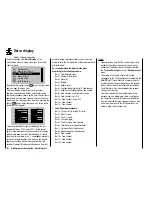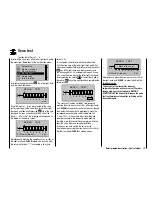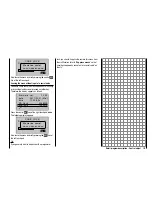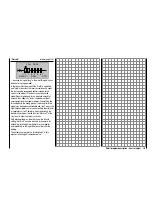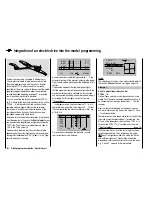
240
Detail program description - Control adjust
"
Aile/fl aps
":
1 or 2 AIL servos and 0, 1, 2 or 4 FL
servos
Since we want to actuate the brake system of the "Brake
settings" submenu under the "
Wing mixers
" menu with
the C1 joystick, we will leave the setting to the outer
right in the "
Brake off
" set to "Input 1". With the "Offset
value" to the left of this, you should only place the mixer
neutral point at the point where the brake system is
retracted or inactive. If, in the process, the offset is not
place completely at the end of the control path, the rest
of the path is "idle travel", which means the mixer is not
infl uenced in this range of the joystick movement.
By now, the servos should be plugged into the receiver
in the standard Graupner sequence:
Receiver power supply
Free or left aileron 2 or aux. function
Rudder
Aileron or left aileron
Elevator or 1st elevator
Receiver power supply
Airbrake or throttle servo
or speed controller (electric motor)
Right aileron or aux. function
Flap or left flap
Right flap or free or aux. function
Comments:
If a V-tail unit should move incorrectly either "high/
•
low" or "left/right", please observe the information in
the table on page 57 in the right column. The same
process applies for the ailerons and fl aps.
The settings described in the following are based on
•
a model with "normal" tail unit and "none (motor)".
The settings are adopted for models with a V-tail with
practically no changes at all. However, the transfer of
this information is not so simple for delta/fl ying-wing
models. Therefore, a special programming example
for this model type is provided on page 272.
In the menu …
""Servo setting"
(page 90)
S1
S2
S3
Rev cent
+
tr v
0%
0%
0%
100% 100%
100% 100%
100% 100%
0%
0%
100% 100%
100% 100%
S4
S5
… the servos can now be adapted to the requirements
of the model for "
Rotational direction
", "
Neutral
position
",
"
Servo travel
" and "
Travel limit
".
In this sense, all settings which serve for the
compensation of the servos and
minor
adaptation to the
model are "necessary".
Notice:
The maximum possible throw of a Graupner servo
•
is 150% per side, based on both mechanical and
electrical reasons. For example, if the the sum of the
values of the columns "Center" and "Servo travel"
exceed this limit, the respective servo can no longer
follow the control commands starting from this point.
Therefore, please bear in mind that the mixer and
settings in the "
Dual Rate / EXPO
" menu also have
an infl uence on the servo travel.
The settings options provided in this menu for
•
asymmetric servo travel do NOT serve for achieving
differentiations for ailerons and/or fl aps. There are
options better suited for this purpose in the
"Wing
mixers"
menu.
In the last column, "
Lim. +
", the basic settings can and
should be taken back signifi cantly from 150% in each
case.
The values entered in this position act as a quasi
"limiter", whereby the setting is actually for which point
of travel the respective servo may not exceed, so that it
does not start up mechanically and thus unnecessarily
draw current. In this case the
End
of the available
mechanical play on the servo, rudder and/or steering is
crucial for the value to be set.
An example of this would be the selection of a model
with cruciform tail, with which the rudder moves in a
wedge-shaped cutout of the elevator. In order to prevent
the rudder on the elevator starting up and possibly
blocking it, the travel is normally mechanically adjusted
(at the linkage) so that the rudder does not start with the
full throw of the joystick. As long as the rudder is only
controlled with the corresponding joystick, there will not
be any further problems with this. Currently, however, in
addition to the normal rudder signal a mixer infl uences
the rudder, such as an "AI
RU" mixer (aileron to
rudder), and the two signals can combine to have an
excessive effect.
A correctly set limit of travel intercedes precisely at this
point and thus reliably prevents the mechanical starting
of the rudder. The limit of travel should, however, not be
too small, so that the rudder throw is permanently and
excessively limited.
Of course, the travel on both sides could, of course,
also be reduced to the that a start-up would not even
occur with an addition of the maximum values. With this
method, however, the prevention of an actually occurring
event would result in a permanent reduction of the
normal rudder throw.
The
Summary of Contents for mx-20 Hott
Page 41: ...41 Your notes...
Page 49: ...49 Your notes...
Page 55: ...55 Your notes...
Page 81: ...81 Your notes...
Page 85: ...85 Your notes...
Page 89: ...89 Your notes...
Page 99: ...99 Detail program description Control adjust...
Page 127: ...127 Detail program description Control adjust...
Page 131: ...131 Detail program description Control adjust...
Page 163: ...163 Detail program description Control adjust...
Page 191: ...191 Detail program description Control adjust...
Page 207: ...207 Detail program description Control adjust...
Page 228: ...228 Detail program description Control adjust...
Page 229: ...229 Detail program description Control adjust...
Page 251: ...251 Detail program description Control adjust...





